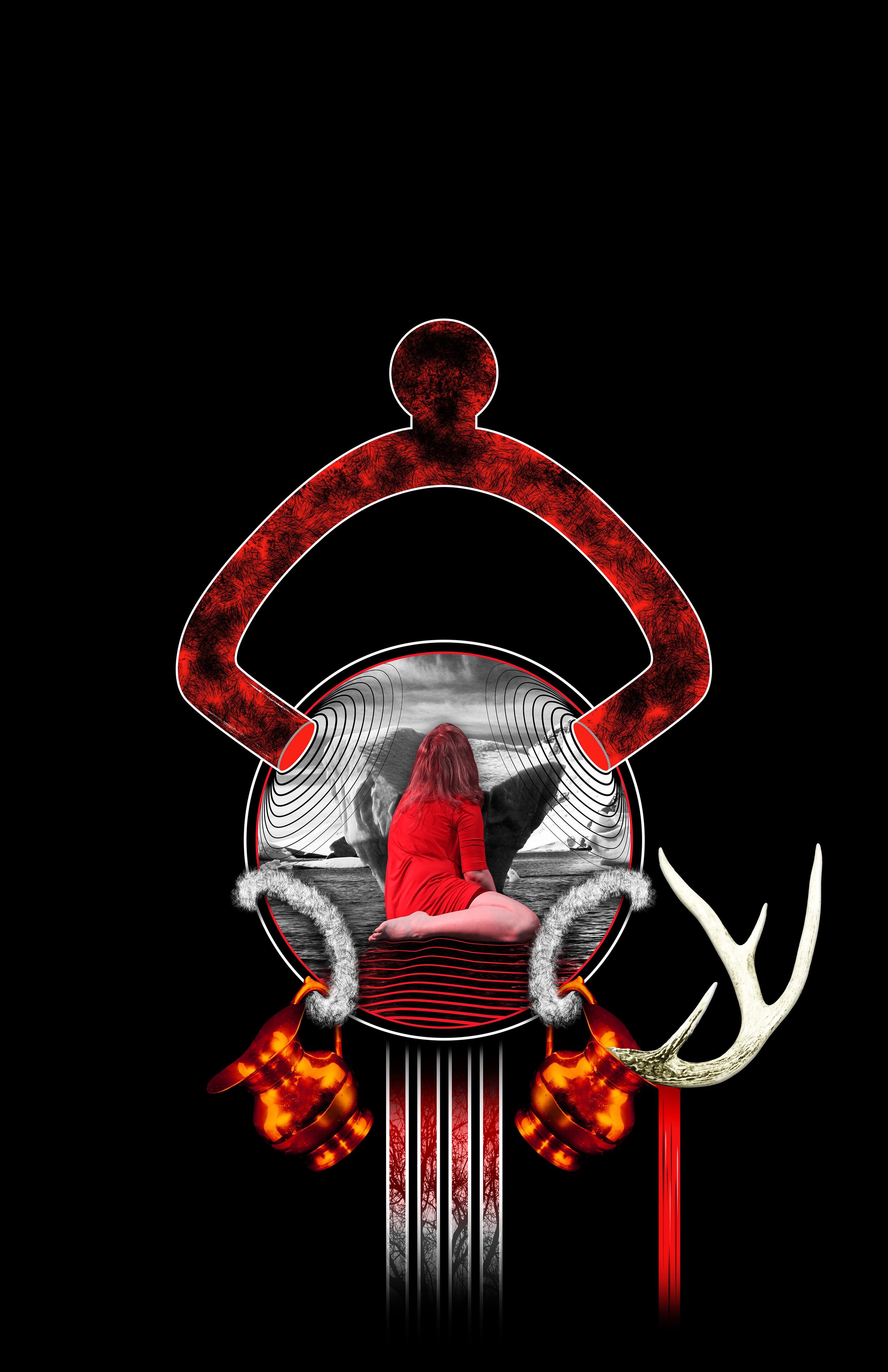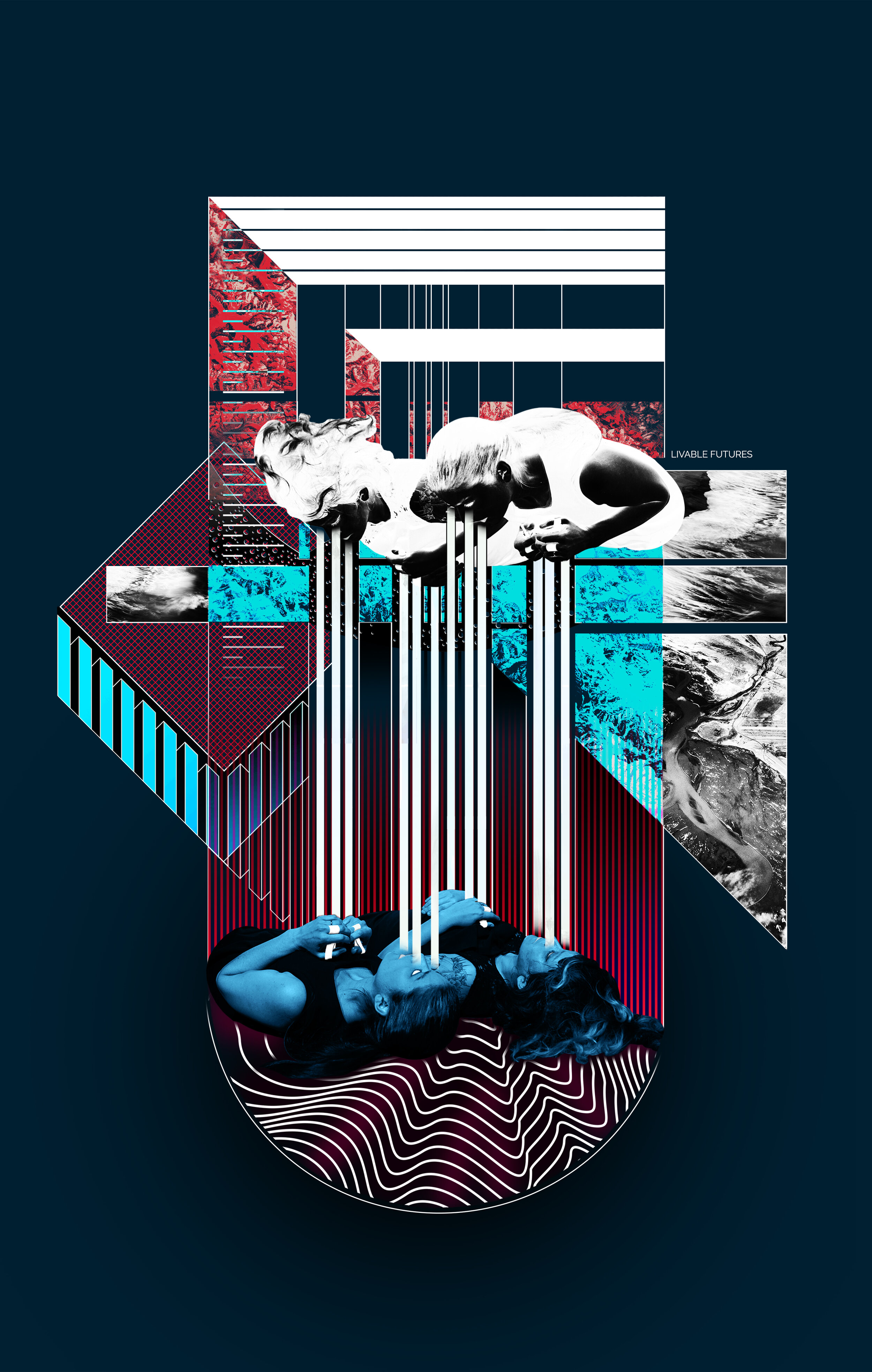One of the core creations emerging from the Livable Futures project is our transmedia performance rituals responding to changing climates and conditions of uncertainty. Called CLIMATE GATHERING, these performances and immersive media installations offer regular communal rituals for audiences seeking new ways to face into the magnitude of climate crisis, remember, and feel into connection and action. In 2019, we have been developing the work through monthly performances for invited groups of students, activists, scientists, scholars, creators and community leaders. In 2020, we head out into the wider world starting with NYC and from there to Australia and wherever we are called next.
What follows are reflections on our 2019 CLIMATE GATHERINGS in images and words written by local journalist and LF contributor, Dan Shellenbarger with collages by designer Taylor Olsen.
Where does it start and where does it end? This can be a question to ask both about climate change and about being an artist. Creator Norah Zuniga Shaw’s Climate Gathering doesn’t ask this question directly but there is no sudden start nor end in the piece. This keeps the audience enmeshed in the work and the questions the work instigates. The work deals with climate change. It both occupies the space of change and occupies the place of frustration of why we, as an intelligent species are letting this happen.
As the beginning and end of the work is not strictly defined, nor are its exact contours. The piece is visually and sonically intense and is different each time it is performed. It is porous and resilient in its design. I have participated in it many times and seen the work adapt to different guest performers. But most often in Columbus, Norah performs with Oded Huberman (her creative partner who is also the Technical Director for all her projects and The Motion Lab @ACCAD where the work has been evolving over the past several years), plus two dancers, Laura Rodriguez and Tara Burns. In each event there are also up to three guest musicians including local DJ Dorian Ham, digital flautist Ann Stimson and computer music composer Marc Ainger. Oded and the musicians perform the interactive media and sound software designed specifically for this work and improvise along with Norah and the dancers.
Together the performers model what Norah calls “a possible response to precarious times, by inhabiting precarity.”
They remain nimble, improvise, seek wisdom and trust that as Norah says in the work “we already know everything we need to know to get started.” And the audience is an active part of this interactive, alert, and alive choice making as well. We do not just sit immobile and watching. We all become participants. Before arriving we are sent a short and simple questionnaire asking about recollections of climate changes and what we see as our strongest skills or “super powers.” The performers integrate this questionnaire in the performance, interspersing our responses throughout, calling on us as teachers. The performers weave themselves through the audience. We are all invited to investigate and participate in the set and the work and given space to determine the scope and scale of our involvement.
I often find myself watching, reflecting, making quiet contributions while others speak into the mic and move through the space. The invitations are clear but it is our choice how we respond to the problems and opportunities presented.
After a quiet beginning, Norah enters the space through sound first, seemingly listening and projecting her singular presence. She has an energy of multitude-ness. She expresses in a way that welcomes and encourages collaboration. And then she transforms, as if dropping into a trance. In this part of the work Norah seems to erupt with rage. She calls this performance state the “banshee” and the connotations of wild, keening, sonic immensity are apt. There are degrees to this rage. Sometimes it feels as if she is speaking for our species. Other times it feels like the rage is at the larger forces and systems of power that brought us here. Then there is the rage that seems to take the role of our planet reacting to the stupidity that has caused such a global catastrophe.
These are my interpretations. The piece is both radically abstract and very concrete. Dressed in a red dress, Norah makes rage somehow cathartic and seductive. The sometimes awkward and ugly utterances and trance-like jerking of her body is somehow humane. Watching her express in movement and fits and starts of word streams makes a viewer feel expressed--she is taking what we feel, what is simmering inside of us, unspoken, unstated and she utters for us, show us what we really feel. We sit back and allow our rage to be channeled through her. She occupies so many senses, it feels like a release. Meanwhile her audible expressions are captured and distorted and amplified by her audio collaborators who also weave in their own sonic threads. There is a din of utterances, water pouring, a flute, stones falling, samples from songs that haunt you long after, snatches of phrases. It makes for a delicious cacophony of sound.
There are many aspects to the idea of “music” of our everyday lives and how the label of “music” comes with so many expectations, rhythm, tonality, melody, etc. But this is our Western idea of music. Climate Gathering directs another trajectory of co-creation between performers and audience. The performers fill the space with emergent sound. Music is too rigid a word, and not monumental enough to capture what happens in the space. Sound so easily can transport a person. The way Norah’s audio collaborators manipulate and distort the sound takes us into the elements of our climate, we can feel the water, the earth, the wind. Norah is the fire. She makes the orbit of our climatic elements for us to reconsider.
The two dancers are silent throughout. Like Norah, they do not have predetermined choreography but instead work in a deeply tuned state of improvisation that grounds the work. In the beginning they look almost like mirrors, a fleeting glimpse of symmetry, support, quiet strength in a very chaotic world. They work off each other and the audience, sometimes in unison, sometimes helping, sometimes creating obstacles. The dancers pass in and out of Norah’s path. They are the ripples from Norah. If Norah is the nucleus, they are the electrons and we need them there in their electric presence.
Viewers are participants. At some point Norah retreats into a tent on stage that is on loan from the Byrd Polar Research Center and has been used in Antarctic expeditions. We are given written suggestions for us to leave our seats and express in ways that we can adapt. Participants have been folks like me, a non-dancer more accustomed to traditional performance, scholars, scientists and highly trained performers and artists. It does something to see a work from inside of it. It is like with climate change--we are a participant no matter how “green” we try to live our lives. When you are an active participant you begin to watch and perform at the same time. I like being in a place where you are doing and observing. Your thoughts are bifurcated, you enter a duality, seeing and doing, being and doing.
I have often felt so frustrated with wanting to change the path of the climate. I do what I can, but I know it is not close to enough. It is a place where the work of one is almost meaningless without the work of others joining. And, even if there is a majority of people working to slow climate change, it only takes just a few large organizations to ruin the work of individuals. It can create a feeling of hopelessness. Participating in Climate Gatherings make everything feel actionable.
This piece helps us feel that with our own energy directed toward change, along with good Earth stewardship, we might be able to slow this. It takes action. Action happens on so many levels. Norah and her collaborators tap us into the energy of emotions without ever saying so, the radical presence she finds in improvisational expression speaks to all of our humanity and connects us with Mother Earth. Norah’s rage, her motions, her utterances both ignite and heal. It is the expression we need, what the Earth needs.
Dan Shellenbarger is a journalist and PhD student in Arts Administration and Public Policy at The Ohio State University





